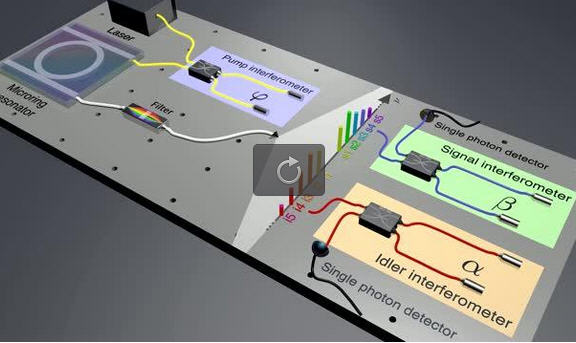INRS takes giant step forward in generating optical qubits

The optical chip developed at INRS by Prof. Roberto Morandotti's team overcomes a number of obstacles in the development of quantum computers. This team has demonstrated that on-chip quantum frequency combs can be used to simultaneously generate multiphoton entangled quantum bit states. It is the first chip capable of simultaneously generating multi-photon qubit states and two-photon entangled states on hundreds of frequency modes. The chip is scalable, compact, and compatible with existing technologies. Credit: Ultrafast Optical Processing Group, 2016.
Quantum computing differs fundamentally from classical computing, in that it is based on the generation and processing of qubits. Unlike classical bits, which can have a state of either 1 or 0, qubits allow a superposition of the 1 and 0 states (both simultaneously).
Strikingly, multiple qubits can be linked in so-called 'entangled' states, where the manipulation of a single qubit changes the entire system, even if individual qubits are physically distant. This property is the basis for quantum information processing, aiming towards building superfast quantum computers and transferring information in a completely secure way.
Professor Morandotti has focused his research efforts on the realization of quantum components compatible with established technologies. The chip developed by his team was designed to meet numerous criteria for its direct use: it is compact, inexpensive to make, compatible with electronic circuits, and uses standard telecommunication frequencies. It is also scalable, an essential characteristic if it is to serve as a basis for practical systems. But the biggest technological challenge is the generation of multiple, stable, and controllable entangled qubit states.
The generation of qubits can rely on several different approaches, including electron spins, atomic energy levels, and photon quantum states. Photons have the advantage of preserving entanglement over long distances and time periods. But generating entangled photon states in a compact and scalable way is difficult. “What is most important, several such states have to be generated simultaneously if we are to arrive at practical applications,” added INRS research associate Dr. Michael Kues.
Roberto Morandotti's team tackled this challenge by using on-chip optical frequency combs for the first time to generate multiple entangled qubit states of light. As Michael Kues explains, optical frequency combs are light sources comprised of many equally-spaced frequency modes. “Frequency combs are extraordinarily precise sources and have already revolutionized metrology and sensing, as well as earning their discoverers the 2005 Nobel Prize in Physics.”
Thanks to these integrated quantum frequency combs, the chip developed by INRS is able to generate entangled multi-photon qubit states over several hundred frequency modes. It is the first time anyone has demonstrated the simultaneous generation of qubit multi-photon and two-photon entangled states: Until now, integrated systems developed by other research teams had only succeeded in generating individual two-photon entangled states on a chip.
The results published in Science will provide a foundation for new research, both in integrated quantum photonics and quantum frequency combs. This could revolutionize optical quantum technologies, while at the same time maintaining compatibility with existing semiconductor chip technology.
###
About the publication
This highly promising breakthrough is described in an article in the prestigious journal Science entitled “Generation of multiphoton entangled quantum states by means of integrated frequency combs” (DOI : 10.1126/science.aad8532). The team that wrote the article is made up of Christian Reimer, Michael Kues, Piotr Roztocki, Benjamin Wetzel, Fabio Grazioso, Brent E. Little, Sai T. Chu, Tudor Johnston, Yaron Bromberg, Lucia Caspani, David J. Moss, and Roberto Morandotti. The research was made possible with the financial support of the Natural Sciences and Engineering Research Council of Canada (NSERC), the Australian Research Council, Fonds de Recherche du Québec – Nature et Technologies (FRQNT), the European Union through the 7th Framework Program and Horizon 2020, Mitacs, and the City University of Hong Kong.
About INRS
Institut national de recherche scientifique (INRS) is a graduate-level research and training university and ranks first in Canada for research intensity (average grant funding per faculty member). INRS brings together some 150 professors and close to 700 students and postdoctoral fellows at its four centres in Montreal, Quebec City, Laval, and Varennes. Its basic research is essential to the advancement of science in Quebec and internationally even as it plays a key role in the development of concrete solutions to the problems faced by our society.
Media Contact
All latest news from the category: Physics and Astronomy
This area deals with the fundamental laws and building blocks of nature and how they interact, the properties and the behavior of matter, and research into space and time and their structures.
innovations-report provides in-depth reports and articles on subjects such as astrophysics, laser technologies, nuclear, quantum, particle and solid-state physics, nanotechnologies, planetary research and findings (Mars, Venus) and developments related to the Hubble Telescope.
Newest articles

A ‘language’ for ML models to predict nanopore properties
A large number of 2D materials like graphene can have nanopores – small holes formed by missing atoms through which foreign substances can pass. The properties of these nanopores dictate many…

Clinically validated, wearable ultrasound patch
… for continuous blood pressure monitoring. A team of researchers at the University of California San Diego has developed a new and improved wearable ultrasound patch for continuous and noninvasive…

A new puzzle piece for string theory research
Dr. Ksenia Fedosova from the Cluster of Excellence Mathematics Münster, along with an international research team, has proven a conjecture in string theory that physicists had proposed regarding certain equations….



